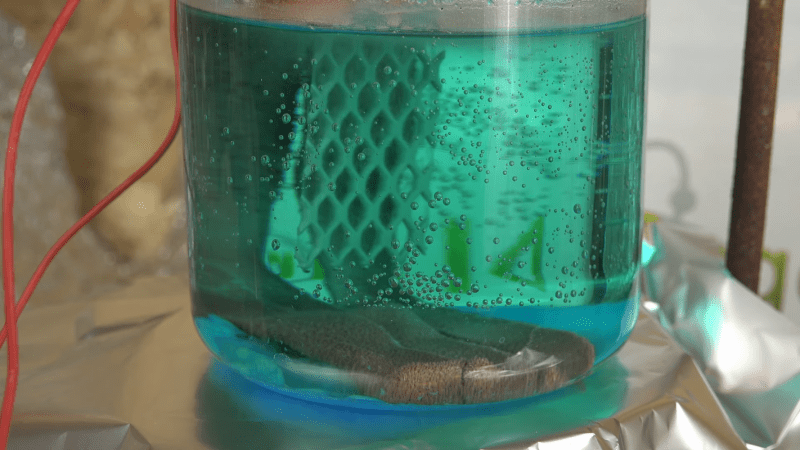Refining precious metals is not as simple as polishing rocks that have been dug out of the ground. Often, complex chemical processes are needed to process the materials properly or in high quantities, but these processes leave behind considerable waste. Often, there are valuable metals left over in these wastes, and [NerdRage] has gathered his chemistry equipment to demonstrate how it’s possible to recover these metals.
The process involved looks to recover copper and nitric acid from copper nitrate, a common waste byproduct of processing metal. While a process called thermal decomposition exists to accomplish this, it’s not particularly efficient, so this alternative looks to improve the yields you could otherwise expect. The first step is to react the copper nitrate with sulfuric acid, which results in nitric acid and copper sulfate. From there, the copper sulfate is placed in an electrolysis cell using a platinum cathode and copper anodes to pass current through it. After the process is complete, all of the copper will have deposited itself on the copper electrodes.
The other interesting thing about this process, besides the amount of copper that is recoverable, is that the sulfuric acid and the nitric acid are recoverable, and able to be used again in other processes. The process is much more efficient than thermal decomposition and also doesn’t involve any toxic gasses either. Of course, if collecting valuable metals from waste is up your alley, you can also take a look at recovering some gold as well.
Thanks to [Keith] for the tip!
















Really great topic with a history that is really neat also.
Especially in modern times researching old mines waste and recovering what was a waste product then and is now a highly valuable commodity material.
Areas of opportunity for R&D. Though like other waste streams say in the chemical industry, consideration needs to be assessed regarding risks and mitigation of short and long term adverse impacts.
Neat to see research where say for like magnets… maybe the rare materials are not required or smaller concentrations are required to have adequate performance. Maybe like this video demonstrates, a simple process may be suitable.
Recycling the already mined materials is also a challenging area of opportunity for R&D… where really making all the systems holistically “greener” will be the most healthiest goal.
There are even areas of opportunity using plants to mine waste materials.
Neat from a chemical engineering perspective to critically study systems processes and utilize to minimize waste and maximize yields… and also reduce health and safety risks. Neat just from a chemistry perspective without the energy balance thoughts.
NerdRage details really well and simply too with noting a range of opportunities which is really awesome to watch. Very inspirational and like chemistry ASMR.
My buddy Chuck, has a Mercedes AMG with the license plate GO4AU .
Yes, he recovers gold from computer scrap.
But if I already have the platinum to do this what do I want copper for?
To sell it and buy more platinum.
You can also reuse the copper on gold recovery through the inquartation technique.
It also has use in the stock pot for cementing precious metals as part of the waste cleanup process.
There’s a guy on YT who goes by the handle ‘sreetips’ and he recovers precious metals from all kinds of things. You can learn this process yourself just from doing what he does.
His videos are pretty good, but there is definitely an overuse of nitric acid in a lot of his reactions. I am sure it comes from a desire for speed, but know that it can be done more efficiently with less waste.
I still watch every one of his videos and this definitely isn’t a complaint. I just want people to be aware of the issue. I would also recommend that anyone who is interested in doing this, find the book from C. M. Hoke called “Refining Precious Metals” and study it well. There are some outdated things in the book like tasting/smelling a solution and pouring stuff down the drain that are not a good idea, so a member of the gold refining forum called Frugal Dave or Frugal Dan has an annotated/updated PDF in his signature.
” From there, the copper sulfate is placed in an electrolysis cell using a platinum cathode and copper anodes to pass current through it.”
It’s the other way around: a platinum anode (+) and copper cathode (-)–see the video at the 7:00 mark. The positively-charged copper Cu2+ cations gain two electrons from the cathode and deposit on the cathode as solid copper.
You put wrongly the two mentioned metals as anode and cathode. Copper rod should be as cathode where copper from the copper sulfate solution will be deposited there.